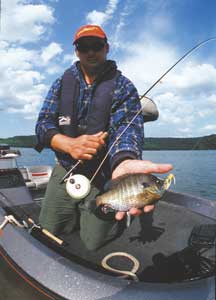
One of my earliest fishing memories as a kid was arriving late at the local pond with my friends and casting balsawood and deer-hair poppers to bluegill and bass with our fly rods. The hottest days of summer led to the best fishing during the evening. As soon as the long shadows fell across the pond’s surface, the fishing would immediately start up.
Big bluegill would whack the small balsawood poppers as we chugged them across the water and an occasional bass would surprise us by charging from the depths and exploding to the surface on one of our flies.
Poppers are still the most widely-used fly for catching both bluegill and bass. Whether they’re made of foam, balsawood, soft plastic, or deer-hair is of little consequence — they simply produce.
There is also no other sight in fishing as exciting as a bass or bluegill shattering the surface of the water to attack a surface lure or fly.
Here are some tips for catching mid-summer bluegills and bass with poppers.
1-Large bluegill like structure adjacent to deep water.
If you find a combination of these features in a small area, you also can find the largest bluegill or bass in that body of water.
During the summer, the big bluegill fish will seek deeper water — as much as 35 feet — in areas near the shallow flats where they feed.
The key during this time of year is fishing the shallow flats when the fish are there — which is early morning and late evening.
2-Use poppers that closely match the size and color of predominant forage of the water you are fishing.
Smaller poppers will catch more fish than larger ones but will catch smaller fish, on average.
Poppers tied or built around size 8 to 12 hooks are ideal for bluegills and can be purchased in most stores for a dollar or two. Poppers for bass are usually size 4 or 6. I prefer smaller ones instead of larger ones.
3-Stalk cautiously. Don’t casually wade or float into the places where you’ll be fishing.
Study the area carefully from a distance before making your first cast or wading into the water.
When wading take your time and try to cause as little noise and surface commotion as possible. This also holds true for those fishermen using a small boat of canoe.
The fewer disturbances you transmit to the surrounding area the better your chances will be.
4-Slow down the presentation.
Insects that fall into the water don’t move fast or far under their own power.
Let your popper sit long enough for the rings to subside before twitching it or popping it. If you’re using a popper with a cupped faced, give it a short, quick pop then give it a period of rest before retrieving it again.
A stop-and-go retrieve with long pauses between movements is a technique that is deadly.
5-A fly rod is the most effective way to cast poppers. Most are just too light to be cast practically with spinning gear.
A six-weight fly outfit is a good, all-around compromise for bluegill and bass — with just enough backbone to cast wind-resistant flies into a stiff breeze but light enough to enjoy the fight of feisty bluegill.
I still enjoy an evening at a lake or small farm pond with a fly rod and a box of poppers. The fish are always agreeable and the top-water strikes always keep you on your toes. This isn’t technical, cerebral fishing. Fly-rodding with popping bugs for bass and bream is just a few hours of fun.
When the summer doldrums hit and mid-day fishing comes screeching to a halt, visit your favorite local pond or lake and get in some early-morning or late-evening top-water bass and bluegill fishing — just for the fun of it.



Be the first to comment